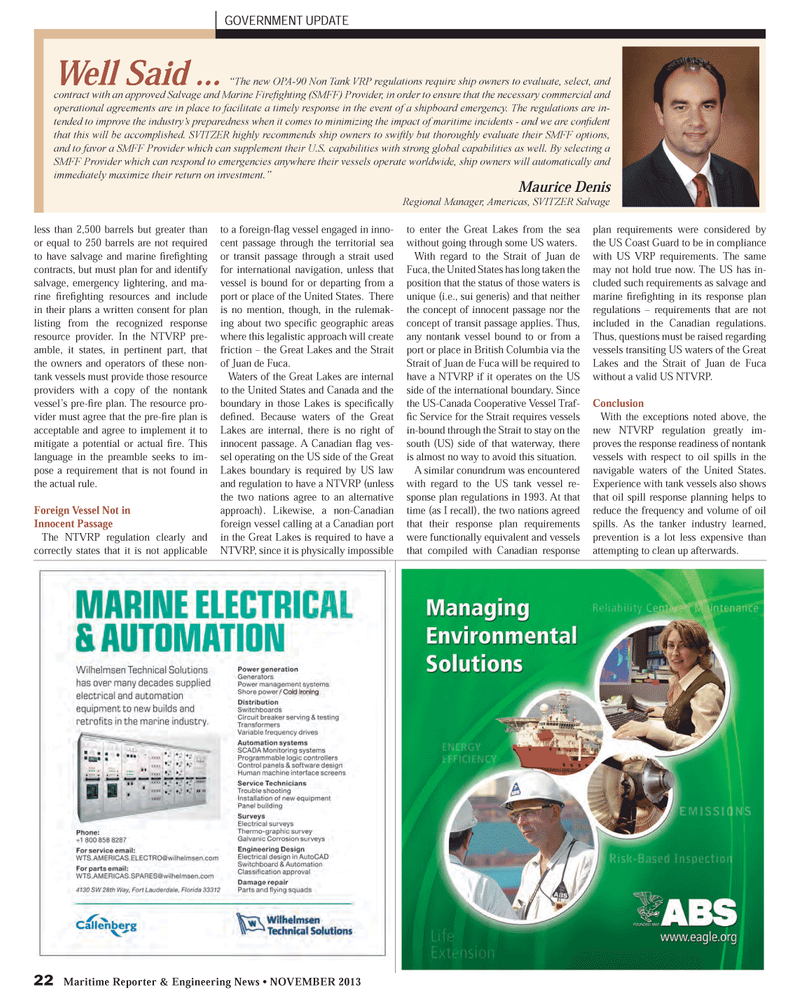
Page 22: of Maritime Reporter Magazine (November 2013)
Marine Propulsion Annual
Read this page in Pdf, Flash or Html5 edition of November 2013 Maritime Reporter Magazine
22 Maritime Reporter & Engineering News ? NOVEMBER 2013 GOVERNMENT UPDATE less than 2,500 barrels but greater than or equal to 250 barrels are not required to have salvage and marine Þ reÞ ghting contracts, but must plan for and identify salvage, emergency lightering, and ma- rine Þ reÞ ghting resources and include in their plans a written consent for plan listing from the recognized response resource provider. In the NTVRP pre- amble, it states, in pertinent part, that the owners and operators of these non-tank vessels must provide those resource providers with a copy of the nontank vessel?s pre- Þ re plan. The resource pro- vider must agree that the pre-Þ re plan is acceptable and agree to implement it to mitigate a potential or actual Þ re. This language in the preamble seeks to im-pose a requirement that is not found in the actual rule.Foreign Vessel Not in Innocent PassageThe NTVRP regulation clearly and correctly states that it is not applicable to a foreign-ß ag vessel engaged in inno-cent passage through the territorial sea or transit passage through a strait used for international navigation, unless that vessel is bound for or departing from a port or place of the United States. There is no mention, though, in the rulemak-ing about two speciÞ c geographic areas where this legalistic approach will create friction ? the Great Lakes and the Strait of Juan de Fuca.Waters of the Great Lakes are internal to the United States and Canada and the boundary in those Lakes is speciÞ cally deÞ ned. Because waters of the Great Lakes are internal, there is no right of innocent passage. A Canadian ß ag ves- sel operating on the US side of the Great Lakes boundary is required by US law and regulation to have a NTVRP (unless the two nations agree to an alternative approach). Likewise, a non-Canadian foreign vessel calling at a Canadian port in the Great Lakes is required to have a NTVRP, since it is physically impossible to enter the Great Lakes from the sea without going through some US waters.With regard to the Strait of Juan de Fuca, the United States has long taken the position that the status of those waters is unique (i.e., sui generis) and that neither the concept of innocent passage nor the concept of transit passage applies. Thus, any nontank vessel bound to or from a port or place in British Columbia via the Strait of Juan de Fuca will be required to have a NTVRP if it operates on the US side of the international boundary. Since the US-Canada Cooperative Vessel Traf- Þ c Service for the Strait requires vessels in-bound through the Strait to stay on the south (US) side of that waterway, there is almost no way to avoid this situation.A similar conundrum was encountered with regard to the US tank vessel re-sponse plan regulations in 1993. At that time (as I recall), the two nations agreed that their response plan requirements were functionally equivalent and vessels that compiled with Canadian response plan requirements were considered by the US Coast Guard to be in compliance with US VRP requirements. The same may not hold true now. The US has in- cluded such requirements as salvage and marine Þ reÞ ghting in its response plan regulations ? requirements that are not included in the Canadian regulations. Thus, questions must be raised regarding vessels transiting US waters of the Great Lakes and the Strait of Juan de Fuca without a valid US NTVRP. ConclusionWith the exceptions noted above, the new NTVRP regulation greatly im-proves the response readiness of nontank vessels with respect to oil spills in the navigable waters of the United States. Experience with tank vessels also shows that oil spill response planning helps to reduce the frequency and volume of oil spills. As the tanker industry learned, prevention is a lot less expensive than attempting to clean up afterwards.Well Said ... ?The new OPA-90 Non Tank VRP regulations require ship owners to evaluate, select, and contract with an approved Salvage and Marine Fire Þ ghting (SMFF) Provider, in order to ensure that the necessary commercial and operational agreements are in place to facilitate a timely response in the event of a shipboard emergency. The regulations are in-tended to improve the industry?s preparedness when it comes to minimizing the impact of maritime incidents - and we are con Þ dent that this will be accomplished. SVITZER highly recommends ship owners to swiftly but thoroughly evaluate their SMFF options, and to favor a SMFF Provider which can supplement their U.S. capabilities with strong global capabilities as well. By selecting a SMFF Provider which can respond to emergencies anywhere their vessels operate worldwide, ship owners will automatically and immediately maximize their return on investment.? Maurice Denis Regional Manager, Americas, SVITZER Salvage MR #11 (18-25).indd 22MR #11 (18-25).indd 2211/11/2013 11:34:41 AM11/11/2013 11:34:41 AM

 21
21

 23
23
